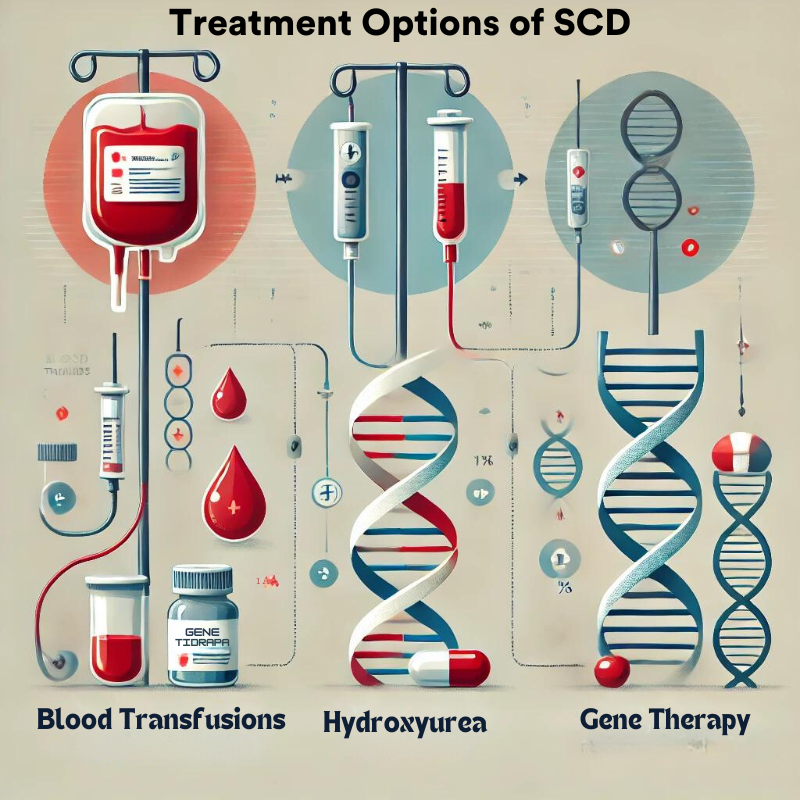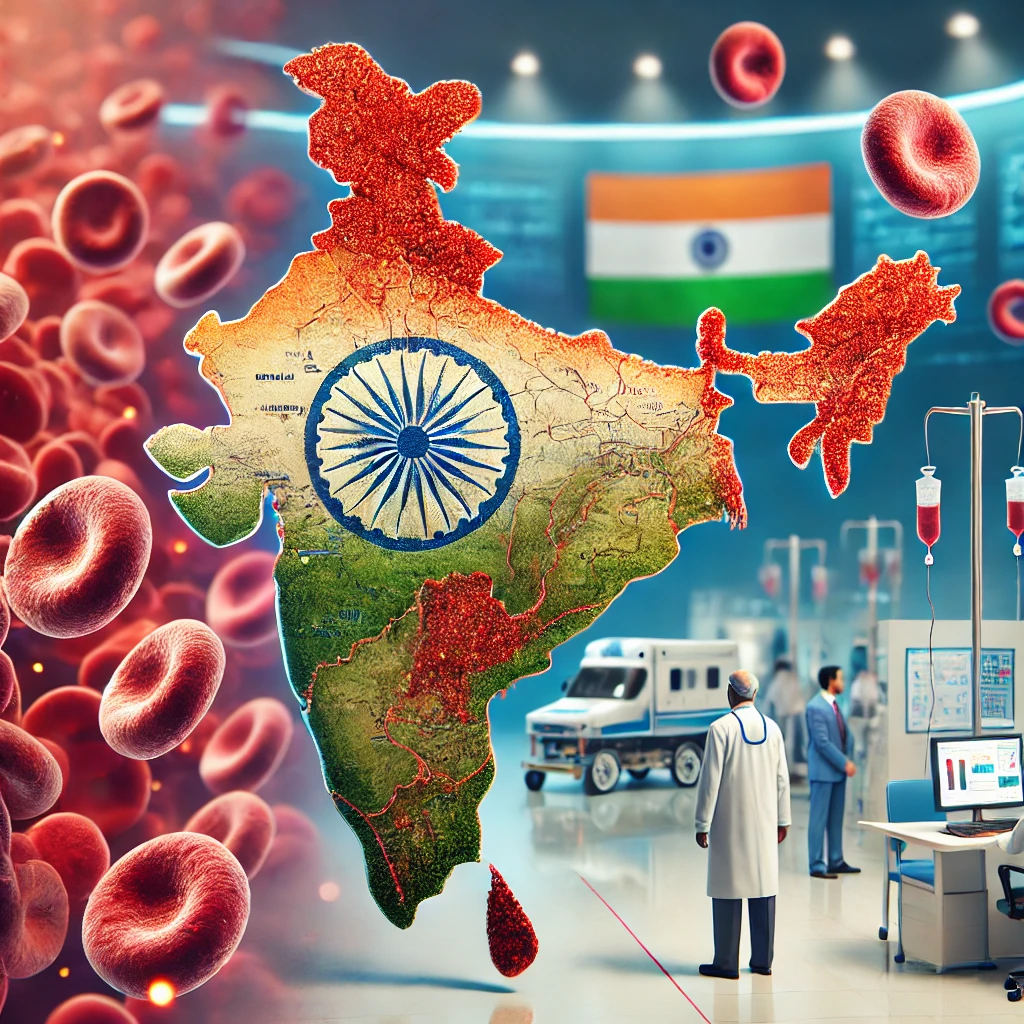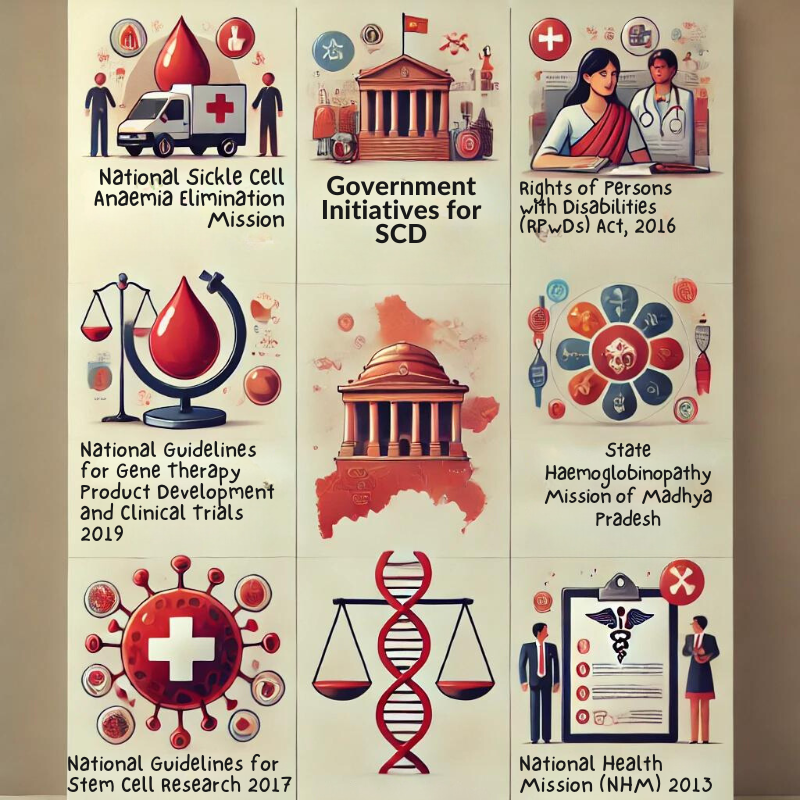Sickle cell disease is one of the pressing public health challenges, mainly from tribal and rural populations, in India, with over 1 million people suffering from it mainly living in tribal belts. The Prime Minister launched the National Sickle Cell Anaemia Elimination Mission in 2023 to eliminate SCD by the year 2047. The disease is associated with misdiagnosis, inadequate healthcare service, and high expenses related to treatment. Thus it needs to be treated seriously to provide better health services.
| GS Paper | General Studies II |
| Topics for UPSC Prelims | Sickle Cell Disease (SCD), Red blood cells (RBCs), Chronic anaemia, Lyfgenia, CRISPR, National Sickle Cell Anaemia Elimination Mission, National Health Mission (NHM) 2013, Rights of Persons with Disabilities (RPwDs) Act, 2016, SDG 3. |
| Topics for UPSC Mains | Current Status of India’s Startup Sector, Roadblocks to the Growth of Indian Startups. |
Origin of the Article
This editorial is based on “India’s Sickle Cell Challenge” published in The Hindu on 12/09/2024. The article discusses the key challenges of sickle cell disease in India and suggests strategies to tackle them.
Relevance for UPSC Students
Understanding the challenges and solutions for sickle cell disease is crucial for UPSC aspirants. It aligns with topics in GS Paper 2, covering government policies, health issues, and SCs & STs. It also helps in developing analytical skills and understanding public health dynamics.
Why in News
The issue of Sickle Cell Disease (SCD) has gained significant attention due to the recent launch of the National Sickle Cell Anaemia Elimination Mission by the Prime Minister. This mission aims to eradicate SCD by 2047, emphasizing its public health impact, especially in tribal areas. The topic is crucial for UPSC aspirants, as it intersects with themes of governance, health policies, and social justice, which have been frequently examined in both Prelims and Mains. Understanding the complexities and proposed interventions for SCD can provide a comprehensive insight into India’s public health challenges and policy responses.
What is Sickle-Cell Disease (SCD)?
Sickle Cell Disease (SCD) is an autosomal recessive genetic disorder, which leads to hemoglobin mutations affecting the shape of red blood cells, giving them a sickle or crescent shape. This sharply limits the patient’s life expectancy to only 40 years and is coupled with many chronic health problems, such as a form of anemia, episodes of pain, recurrent infections, and damage to many organs.
SCD is a genetic disorder characterized by a mutation of red blood cells into a sickle shape, which subsequently clogs the flow of blood and oxygen within the body. Overall, patients with this disorder experience a relatively shorter life expectancy as well as other complications, such as chronic anemia, recurring pains, infections, and organ damage.
Causes
SCD is a genetic disorder present from birth, inherited when a child receives two genes that code for abnormal hemoglobin—one from each parent. This hereditary nature means that the disease is passed down through generations.
Types of Sickle Cell Disease
The type of SCD a person has is determined by the specific genes inherited from their parents. The major types include HbSS, HbSC, and HbS beta thalassemia. Other less common combinations involve genes like HbSD, HbSE, and HbSO, each presenting varying degrees of severity.
Symptoms
Common Sickle Cell Disease symptoms include chronic anemia, which leads to fatigue and weakness, painful episodes known as sickle cell crises, and delayed growth and puberty. These symptoms can significantly impact the quality of life and overall health of affected individuals.
Sickle Cell Disease Treatment Processes
SCD Treatment includes blood transfusions to alleviate anemia, Hydroxyurea to reduce pain episodes, and gene therapy such as CRISPR. These treatments aim to manage symptoms and prevent complications, although a permanent cure remains elusive.

Differences Between Sickle Cell Anemia and Sickle Cell Disease
| Aspect | Sickle Cell Anemia | Sickle Cell Disease |
|---|---|---|
| Definition | A specific form of sickle cell disease where individuals have two sickle cell genes. | A group of inherited red blood cell disorders that include various forms, such as Sickle Cell Anemia. |
| Genetic Cause | Caused by inheriting two hemoglobin S genes, one from each parent. | Caused by inheriting hemoglobin S gene along with another hemoglobin gene like C, D, E, or another S. |
| Symptoms | Anemia, episodes of pain, swelling in hands and feet, frequent infections, delayed growth. | Similar to sickle cell anemia, but severity and specific symptoms can vary depending on the specific type of disease. |
| Diagnosis | Hemoglobin electrophoresis to identify hemoglobin types. | Hemoglobin electrophoresis, but interpretation differs based on the combination of hemoglobin types present. |
| Treatment | Pain management, blood transfusions, hydroxyurea, potentially bone marrow transplant. | Similar treatments but tailored to specific complications and severity of the disease. |
| Complications | Stroke, acute chest syndrome, organ damage, increased infection risk. | Can include all complications of sickle cell anemia but varies more based on the type of SCD. |
| Inheritance Pattern | Autosomal recessive; both parents must pass on the S gene. | Autosomal recessive; inheritance of S gene from one parent and another abnormal hemoglobin gene from the other. |
What is the Prevalence of Sickle Cell Disease in India?
Sickle Cell Disease is a significant public health concern in India, particularly among tribal populations. With over 1 million affected individuals, India bears the world’s second-largest burden of SCD. The country ranks third globally in SCD births, and the carrier rate among tribal groups can vary from 1 to 40%. The highest concentrations of SCD patients are found in Odisha, Jharkhand, Chhattisgarh, Madhya Pradesh, and Maharashtra.
Public Health Concern
The Ministry of Health and Family Welfare has identified SCD as one of the ten major health issues disproportionately affecting India’s tribal communities. This recognition underscores the urgent need for targeted interventions and healthcare improvements in these regions.
Global Burden
India accounts for the second-highest number of SCD in the world, with over 1 million sufferers. Therefore, the importance of national health strategies and international collaborations cannot be overstated.
SCD Birth Rates
India ranks third globally in the number of SCD births, following Nigeria and the Democratic Republic of the Congo. This statistic underscores the critical need for early detection and intervention programs to manage the disease from birth.
Carrier Rate
The prevalence of sickle cell carriers among India’s tribal groups ranges from 1 to 40%. This variation necessitates targeted screening and genetic counseling to manage and mitigate the spread of the disease within these communities.
Geographical Distribution
Regions with the highest concentration of SCD patients include Odisha, Jharkhand, Chhattisgarh, Madhya Pradesh, and Maharashtra. These areas require focused healthcare interventions and resources to manage the disease effectively.

Key Challenges Encountered by SCD Healthcare System in India
The challenges in managing SCD are numerous, including the fact that the cure for the disease remains an elusive permanent end, frequent misdiagnosis, poor healthcare infrastructure, inconsistent access to medicines, high cost of treatment, and lack of research and data. Cultural and social barriers also hamper adequate management of the disease.
No Permanent Cure
There is currently no permanent cure for SCD. While gene therapy shows promise, it remains unaffordable for most patients, highlighting the need for accessible and cost-effective treatment options.
Misdiagnosis
Accurate diagnosis of SCD is hindered by stigma and the reliance on traditional healers, leading to frequent misdiagnosis. This issue underscores the need for increased awareness and education within affected communities.
Inadequate Healthcare Infrastructure
Many rural and tribal areas lack specialized healthcare facilities and trained medical personnel, impeding timely intervention and effective disease management. Improving healthcare infrastructure in these regions is crucial.
Inadequate Screening Programs
The absence of systematic newborn screening and early detection initiatives results in missed opportunities for early intervention. Expanding these programs is essential for managing SCD effectively.
Limited Access to Medicines
Only 18% of the victims are on regular treatment because of medication stockouts for the disease known as sickle cell disease; travel distances are long and time-consuming. The idea of ensuring regular access to essential drugs is important for effective management of diseases.
High Treatment Costs
The financial burden of long-term SCD management is significant, with treatments like CRISPR costing $1-2 million. This high cost makes it challenging for most families to afford necessary care.
Inadequate Research and Data
Limited research on SCD, particularly in India’s diverse populations, hinders the development of effective treatment strategies. More comprehensive research is needed to tailor public health interventions to local needs.
Cultural and Social Barriers
Stigma and social attitudes towards SCD discourage individuals from seeking treatment, affecting overall health outcomes. Efforts to reduce stigma and promote public health education are essential.
What are Government Initiatives Regarding SCD?
The Government of India has undertaken a set of programs to counter SCD. A few amongst them are National Sickle Cell Anaemia Elimination Mission, NHM 2013, and other guidelines for stem cell and gene therapy research. Similarly, there exist state-specific missions as well as legal provisions through The Rights of Persons with Disabilities Act.
National Sickle Cell Anaemia Elimination Mission
This mission aims to enhance care for SCD patients and reduce disease prevalence through screening and awareness campaigns, targeting the elimination of SCD as a public health concern by 2047.
National Health Mission (NHM) 2013
NHM offers provisions for the prevention and management of diseases, targeting hereditary conditions such as SCD. It makes people aware, enables early detection, and assures that patients receive timely treatment.
National Guidelines for Stem Cell Research 2017
These guidelines restrict the commercialization of stem cell therapies to clinical trials, except for bone marrow transplantation for SCD. Gene editing on stem cells is permitted only for in-vitro studies.
National Guidelines for Gene Therapy Product Development and Clinical Trials 2019
These guidelines provide a framework for developing and conducting clinical trials for gene therapies in inherited genetic disorders, supporting advancements in SCD treatment.
State Haemoglobinopathy Mission of Madhya Pradesh
This mission focuses on screening and managing SCD, addressing specific regional challenges, and improving care for affected individuals.
Rights of Persons with Disabilities (RPwDs) Act, 2016
SCD is included in the RPwDs Act, providing benefits such as reservations in higher education and government jobs, and free education for children with benchmark disabilities.

Steps Taken to Effectively Combat SCD
Broad strategies in place against SCD include combat of stigma, ease of detection and screening, providing access to care, launching immunization campaigns, and promotion of research and development. These will be important factors in the improvement of health outcomes and also in reducing the burden of SCD among patients in India.
- Reduce Stigma and Foster Trust: Leveraging successful health campaign strategies from the past can help reduce stigma and foster trust in public health institutions, encouraging affected individuals to seek treatment and support.
- Early Detection and Screening: Increasing newborn screening and expanding genetic counseling and testing programs are essential for early detection and intervention, which can significantly improve disease management.
- Enhancing Accessibility to Care: Ensuring the availability of essential drugs and support at local health centers, and establishing interdisciplinary centers of excellence can enhance care accessibility and improve patient outcomes.
- Implementing Catch-Up Vaccination Programs: Ensuring that all known SCD patients receive approved vaccines is crucial for preventing complications and improving overall health outcomes.
- Research and Development: Allocating more resources for ongoing medical research and gaining deeper insights into the genetic aspects of SCD can lead to more effective treatments and potential cures, benefiting affected populations.
PESTEL Analysis
| Political: Government initiatives like the National Sickle Cell Anaemia Elimination Mission and Rights of Persons with Disabilities Act play a vital role in fighting SCD. Political intent is required to sustain long-term health campaigns, complemented with sufficient funding and legislation backing public health strategies. Economic: Treatments like gene therapy are very expensive, and chronic management of SCD inflicts heavy economic burdens on healthcare systems. Therefore, it is important to plan the finances. Economic factors also have impacts on access to advanced therapies and routine health services, especially in the rural and tribal regions. Social: There are social stigmas, which lead to misdiagnosis and underreporting of SCD. Cultural perceptions bring about constraints in participation in screening programs and acceptance of modern medical interventions, hence influencing patient outcomes. Technological: There is a great hope, based on gene therapy and stem cell treatment, toward curing SCD. The costs of these treatments are high, and they are difficult to access, so therefore very few people can afford them. Increased investments in medical research and development will improve access to medical care. Environmental: The environmental impact on SCD is not as direct, but geographic location often far from cities can influence the delivery of health care services and thus the effective implementation of screening and treatment programs. Legal: Legal frameworks strengthen the rights and healthcare access of patients with SCD. Putting rules on the process of research on stem cells and gene therapy creates ethical practices in the invention of medical processes. The legislation on the requirements or best interims should be set to set affordability along with the provision of insurance coverage for long-term treatment. |
Conclusion
Improved early detection, better healthcare infrastructure, and public education about sickle cell disease in India could contribute to improving healthcare in India, advancing the realization of SDG 3 (Good Health & Well Being) and SDG 10 (Reduced Inequality). Thus, sustained commitment and coordinated efforts can potentially alter the management landscape of sickle cell disease in India, improving health outcomes and, consequently, the suffering associated with this debilitating condition.
| UPSC Civil Services Examination, Previous Year Questions (PYQs) Mains Q. Examine the role of gene-editing technologies like CRISPR in the treatment of genetic disorders such as Sickle Cell Disease. How could these technologies contribute to achieving Sustainable Development Goal 3 (SDG 3) related to health and well-being? (GS Paper III, 2015) Q. Despite the presence of policies like the National Health Mission (NHM) 2013 and the Rights of Persons with Disabilities Act 2016, the prevalence of Sickle Cell Disease in India remains a major concern. Critically analyze the key gaps in policy implementation and suggest measures to address these gaps effectively. |

